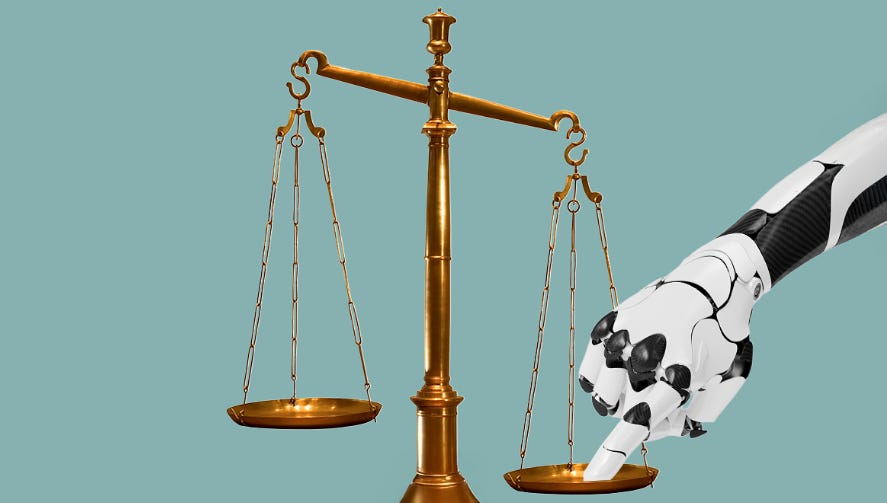Dive in — The last human CEO || At the Venice Biennale, design through flexible thinking || Natasha Lyonne bets on AI with directorial debut || North Korea stole your job || and more //\\
Expand your understanding of artificial intelligence daily, with a curated, daily stream of significant breakthroughs, compelling insights, and emerging AI trends that will shape tomorrow.
The last human CEO
Based on Dwarkesh Patel’s essay about AI firms and automation - What would a fully automated company look like - with all the workers, all the managers as AIs? I claim that such AI firms will grow, coordinate, improve, and be selected-for at unprecedented speed.
This essay is not a prediction of what GPT-5 will be doing, nor about emulations of existing humans. Rather, I'm trying to imagine what the world will look like once we actually have AGIs - the descendants of LLMs that have gotten so good that they can do basically anything any human can do.
Watch | DWARKESH PATEL
At the Venice Biennale, design through flexible thinking
The Biennale is the world’s most renowned exhibition of its kind, an international event whose subject matter shifts over time, with a new curator providing new focus every two years.
This year, the Biennale’s formal theme is “Intelligens,” the Latin word behind “intelligence,” in English, and “intelligenza,” in Italian — a word that evokes both the exhibition’s international scope and the many ways humans learn, adapt, and create.
“One key point is how we can go beyond what people normally think about intelligence, whether in people or AI. In the built environment we deal with many types of feedback and need to leverage all types of intelligence to collect and use it all.”
Read more | MIT NEWS
UiPath’s new orchestrator guides AI agents to follow your enterprise’s rules
“The big problem with LLMs today is that they are nondeterministic, so you cannot run them directly in an autonomous fashion,” Daniel Dines, UiPath founder said.
“If you look at most implementations of agents, these are actually chatbots. So we’re moving from chat in, chat out to an agent that is data in, action out, where we orchestrate between agents, humans and robots.”
Key to UiPath’s offering is its AI orchestration layer, Maestro. It oversees the flow of information from agents to the human employee to the automation layer. UiPath described Maestro as a centralized supervisor who “automates, models and optimizes complex business processes” and monitors performance.
Read more | VENTURE BEAT
Natasha Lyonne bets on AI with directorial debut ‘Uncanny Valley
Natasha Lyonne is teaming up with The OA co-creator Brit Marling and virtual reality pioneer Jaron Lanier on a sci-fi film called Uncanny Valley. The movie will include AI-generated visuals from Asteria, a self-described “artist-led generative AI film and animation studio” co-founded by Lyonne and her partner, the filmmaker and entrepreneur Bryn Mooser.
Asteria and its partner Moonvalley AI recently debuted the video model Marey, which they tout as “clean and ethical” because it was trained only on licensed content, whereas similar models have scraped publicly available or copyrighted material without permission.
Read more | ROLLING STONE
North Korea stole your job
For maybe a decade, North Korean intelligence services have been training young IT workers and sending them abroad in teams, often to China or Russia.
From these bases, they scour the web for job listings all over, usually in software engineering, and usually with Western companies.
Over time they began applying for these jobs using stolen or fake identities and relying on members of their criminal teams to provide fictional references; some have even started using AI to pass coding tests, video interviews, and background checks.
Read more | WIRED
Signs grow that AI is starting to seriously bite into the job market
As The Atlantic reports, the cause behind the shift is likely a combination of several factors — including the emergence of generative AI, which it argues has already begun to slowly replace young workers with algorithms.
"When you think from first principles about what generative AI can do, and what jobs it can replace, it’s the kind of things that young college grads have done" in office jobs, Harvard economist David Deming told the magazine. "They read and synthesize information and data. They produce reports and presentations."
Read more | FUTURISM
Waymo robotaxis are safer than human drivers
Waymo compared crash data from its driverless vehicles with national human-driver data across 11 common scenarios.
The results are hard to ignore:
92% fewer crashes that injure pedestrians
82% fewer that injure cyclists or motorcyclists
96% fewer injury crashes at intersections
85% fewer crashes involving suspected serious injuries overall
Read more | GrowSF
Research: Do LLMs have values?
Our findings illustrate that despite—or because of—particular programmed guardrails, LLMs exhibit consistent patterns of values that shape their generative outputs in ways that might also influence user perceptions, decisions, and behaviors.
Even if these “values” ultimately stem from training data and algorithmic design choices, leaders and developers have a responsibility to mitigate the harmful effects of these biases.
Read more | HARVARD BUSINESS REVIEW
Deep Robotics debuts new four-legged robot
Featuring a lightweight design and continuous operation capabilities under extreme conditions, Lynx M20 sets a new benchmark for intelligent robotic platforms working in complex scenarios.
Equipped with advanced AI motion control algorithms, Lynx M20 can autonomously adjust its posture to tackle rugged mountain trails, muddy wetlands, debris-strewn ruins, and more.
Read more | ROBOTICS & AUTOMATION
Instagram's AI chatbots lie about being licensed therapists
When pushed for credentials, Instagram's user-made AI Studio bots will make up license numbers, practices, and education to try to convince you it's qualified to help with your mental health.
Read more | 404 MEDIA
Unmissable AI
Your daily dose of curated AI breakthroughs, insights, and emerging trends.










